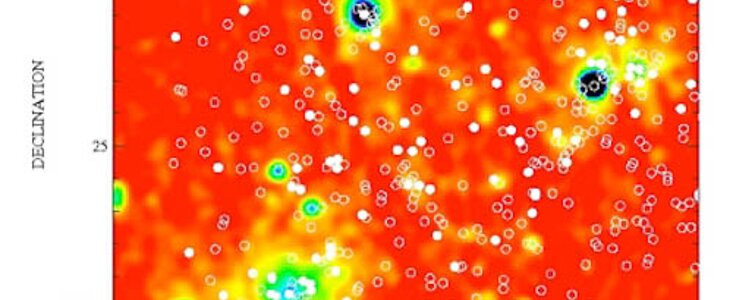Dynamical Analysis of the Abell 1882 Super Group of Galaxies
7 January 2010
Gemini Astronomer Percy Gomez presented the work of an international research team (Gemini, Chile and Canada) studying the dynamics of the super group of galaxies Abell 1882. His oral presentation on Wednesday, January 6th was part of the Galaxy Cluster I session at the 215th meeting of the American Astronomical Society.
The Abell 1882 super group of galaxies is located at redshift z=0.138, and it is anticipated to eventually form a massive galaxy cluster like Coma. The adjacent figure from this work presents an overlay of the extended X-ray emission originating from at least three distinct groups of galaxies. It also shows the position of the galaxies in the cluster. The team identified over 300 galaxy member candidates (open circles) in the cluster from the SDSS photometric survey and used the Gemini Multi-Object Spectrograph on Gemini South (GMOS-S) to measure new redshifts for over 90 galaxy members. In this way the team almost tripled the number of available redshifts for this system. A comparison of the kinematical data with N-body numerical simulations allowed the team to estimate the mass of the system (~ 2x1014 solar masses) and predict that in about 2Gyr the system will form a Coma-like cluster. Unlike high-z super clusters, which will eventually coalesce and form very massive cluster, Abell 1882 will form a typical galaxy cluster like Coma. Studying clusters like Abell 1882 allow researchers to understand in great detail the birth of common clusters. Moreover, this system is located in the nearby universe so it is possible to study it in greater detail than is possible for other super groups at higher redshifts. According to Gomez, the GMOS-S data add an important piece of information to the current pool of X-ray, mid-infrared and upcoming near-infrared data.


